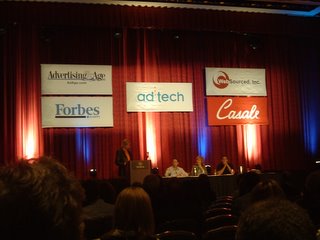
AdTech Daily, Nov 7, 2005 - New York City
What do you get when you combine 200 exhibitors, 42 workshops, 7 keynote addresses and 8500 pre-registered attendees? The world’s largest interactive conference: AdTech 2005.
Back in 1995 when AdTech was first launched, discussion among exhibitors and conference attendees speculated on whether or not the Internet would be around in 10 years. Taking residence at New York’s Hilton Hotel, AdTech is celebrating it’s 11th consecutive year and billed as the world’s largest gathering of interactive advertising professionals. And judging from the diverse activities and opinions expressed throughout the day, AdTech is embracing a far greater scope of ideas and techniques than ever before. Today’s blog provides an overview from the perspective of MetricsDirect participation as both an exhibitor and attendee of AdTech’s many workshops and educational sessions.
Day One was kicked off by educational sessions by a pair of thought provoking keynote speakers: Debra Wahl Meyer, VP Marketing for Toyoto Motor’s Lexus brand discussed brand strategy in “The Age of Engagement” using Lexus’ promise of creating a “covenant” with customers to deliver a “luxury experience” at every point of interaction with the product and the brand. Lexus is using interactivity to enhance “intimacy and fluid access” with consumers citing it’s recent launch of the “New IS” model. The company invited customers to load personal photos to www.thenewis.com that would be integrated in a digital photo montage of the company’s new product and displayed dynamically in an electronic billboard NY’s Times Square. Using live chat interactivity on Edmonds.com, Lexus’s General Manager held a live chat session with over 400 sports cars enthusiasts prior to launch and anticipating potential criticisms of the new model before it was release. This tactic neutralized potential criticism the vehicle may have received had Lexus waited until launch to establish dialogue with this important influencer audience.
In a media environment characterized by a bewildering array of media choices confronting today’s consumers, Sean Dee, VP Marketing of Hard Rock International emphasized the critical importance for brands to establish a unique visual identity. Just 20 years ago, a television advertiser could buy a spot on the #2 rated television show (trivia - “Family Ties” starring Michael J Fox was the #2 rated show in fall of 1985) and reach a potential audience 46MM. Today’s top rated show (CBS’s “CSI”) delivers less than _ of that audience size. To make your message stick, Dee recommends translating a brand into image iconography that resonates emotionally with your consumer. For Hard Rock’s “I Rock NY” new store opening, HR relied on image of rock icons (The Who, Johnny Cash, Jim Hendrix, The Ramones, Nirvana) that reflected the core attributes of Hard Rock’s brand: authentic, passionate, irreverent, unpredictable, and democratic.
Taking a break from some of the big ideas surfaced by these big thinkers, the Sales Team from MetricsDirect immersed itself in what we do best: service customers and optimize campaigns. With over 40 pre-scheduled appointments to supplement the steady stream of traffic that was running past our booth, we had numerous opportunities to interact with current customers as well as meeting nearly one hundred new contacts.
The most common feedback from customers visiting the booth:
1) Service from MetricsDirect is always exceptional
2) MetricsDirect self service web site beats all of its competition
3) MD’s new Behavioral Targeting product is a welcome complement to our traditional CPV product

Keith Smith, CEO, along with Quinn McKee, Account Manager and Matt Doden, Account Executive welcome customers and prospects to MetricsDirect booth at AdTech New York, Nov 7, 2005
After a welcome lunch break we returned to a busy exhibit hall with more meetings and drive buys packing the schedule. The afternoon also featured some terrific workshops. Two that were sampled were “Marketing to Women and Children in the 21st Century” and “Internet Brand Marketers and ‘How Pure Play Works Best’”.
A panel discussion among advertisers and market research firms focused on women were emphatic in their assertion that women in the 21st century are a diverse market set with a wide variety of interests and concerns. To create actionable campaigns, Mary Meehan, EVP of Iconoculture, classified 21st women in the following segments:
• Boomer Women: Age 41-59 years old, these women are accustomed to managing it all and associate with brands that above all provide convenience and control. Meehan noted that this segment also contains a subset of Boomer Grandparents citing the average age of a grandmother is 48 years old and number 32 million in the US. These are not your grandma’s grandmother; these women are active, engaged, involved and technologically, very sophisticated with money, lots of money, to spend.
• GenX Women: Age 28-40 years old, GenX’ers are discerning, realistic and pragmatic. “Good enough” will do. They respect authenticity and real voices. These are the women that are blogging and spending time online chatting.
• Latina: Age 21 -44 years old, Latina’s are avid learners and are on a quest to define their identity. Latina is Super Mamá. She can do it all and wants information, support and community.
• Millenials (aka Gen Y’s) age 21-27 years old expect things their way. This is the “cut and paste” generation that is accustomed to support. Everything must be personalized, customized, and shareable.
Lable Networks CEO Kathleen Gasperini added her perspective to the panel. Advertisers like Apple and Burton Snow Boards use these techniques to appeal to youth culture in the 21st century:
• Imagination – speak to youth in a way that demonstrates yours
• DIY – let youth discover your brand
• Viral Cred – blogs provide independent stamp approval to your brand
• Driving Subcultures – Music, Tech, Sports, Fashion are the real drivers
• Be a part of their lifestyle – it’s not enough to have youth buy your product
Turning attention from theory to practice, top internet brands Shutterfly, LowerMyBills and ELoan discussed the techniques they use to drive traffic, sales and life time value from their respective customer base.
Matt Coffin, CEO of LowerMyBills describes the company’s marketing strategy as “Go big or go home.” Living up to this aspiration, LMB is the internet’s largest financial services advertiser spending over $10MM per month using online advertisinig as a primary vehicle to acquire customers supplemented by traditional print, outdoor and television buys.
ELoan CEO Catherine Muriel takes a more surgical approach to acquiring its younger demographic of 35 y.o. customers relying on exhaustive data analysis to identify the most effective sources of leads and conversions. ELoan use on a mix of search engine marketing, contextual and behavioral networks to manage its brand. Similarly, Shutterfly CEO, Jeff Housenhold cites his company’s effective use of partner marketing (eg: 800flowers co-op mailing) combined with rigorous customer life cycle data analysis to drive their marketing and promotions. Shutterfly has developed over 100 customer segment profiles based on demographics, psychographics and past product consumption to stimulate creative, build traffic and effect conversions.
During Q&A, all three CEO’s cited proficiency at statistics and analytics as the most highly prized skill set their organizations will require for future success. When asked “ If you could select one of the following wishes to predict success for your business, what would you choose: Eliminating your largest competitor, doubling your marketing budget or identifying a new high performing advertising network, all of these internet brand CEO’s selected doubling the marketing budget as the best of the three.
Monday’s sessions were closed appropriately by a highly engaging keynote address delivered by Saatchi & Saatchi, CEO Kevin Roberts. Roberts, author of Lovemarks, The End of Brands, and self described “bald, fat, rich white guy” prognosticated on the “screen age” that consumers in the 21st century live in and the opportunity for all marketers to take advantage of SISOMO: as described in Robert’s new book SISOMO, The Future on Screen. (Screens are defined as cell phones, tv, computer, devices, signage, etc). Roberts implores marketers to take advantage of SISOMO to deliver emotion to drive choice in the “attraction economy” where choice is driven by emotion and emotion leads consumers to take action.
Using a mix of tv spots (New Zealand Blacks rugby team, Brazilian beer, New Zealand Telephone, Lexus IS) Roberts illustrates how SISMO inspires “loyalty beyond reason”. All of the spots relied on strong story telling and make magical the moment of truth when the subject of the ad endorses the product. Roberts also warned how market research and testing can deaden creativity; the only measure that counts: “Do you want to see it again?” Make products irresistible. Roberts challenged conventional thinking about brand marketing, saying “brands do not own consumers, but consumers own the brand.” Apple has such incredible brand loyalty because the consumers of Apple own the emotional connection and affinity for the brand. To build this kind of loyalty, Roberts encouraged those advertisers who are attracted to the efficacies of CRM to stop asking customers for permission, and instead create attraction through the use of mystery, sensuality and intimacy. Using the tools of story, music and humor advertisers can create the attraction that the will connect consumers to a “lovemark” not merely a brand. Roberts ended the session re-capping the thoughts above recommending that “instead of making your next call to your office, call your Mom and Dad instead.”

SISOMO Guru and Saatchi & Saatchi CEO, Kevin Roberts implores AdTech attendees, “Don’t call your office, call your mom & dad.” Nov 7, 2005
Time for one more meeting at the suite, before I think I’ll take Kevin's advice and call home.




No comments:
Post a Comment